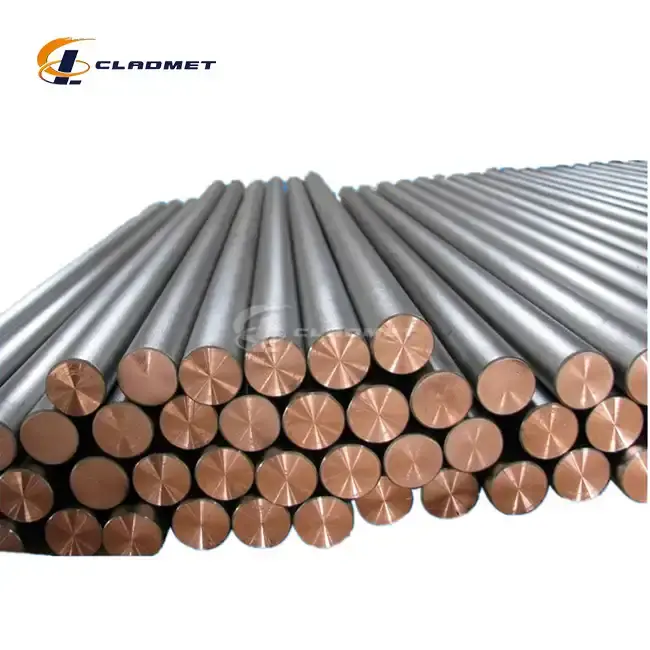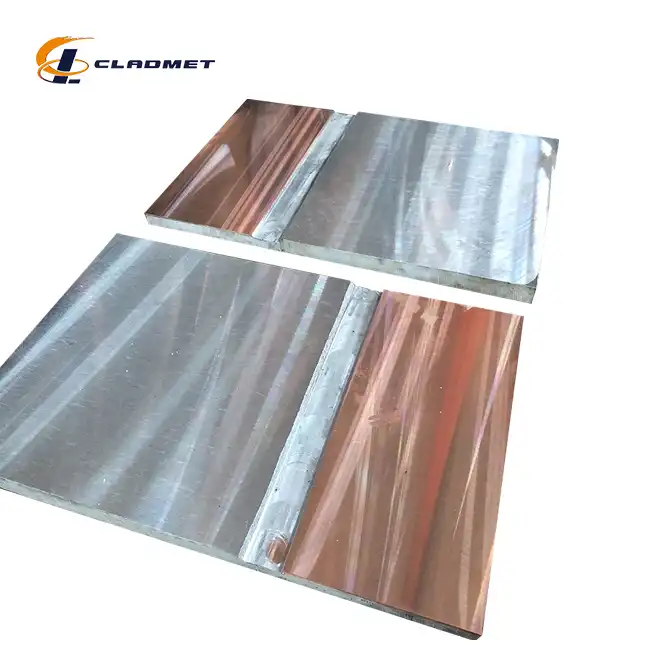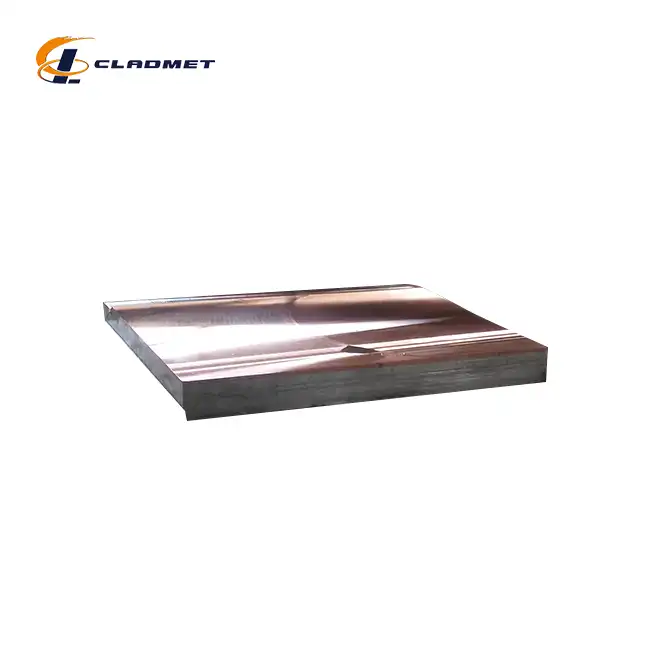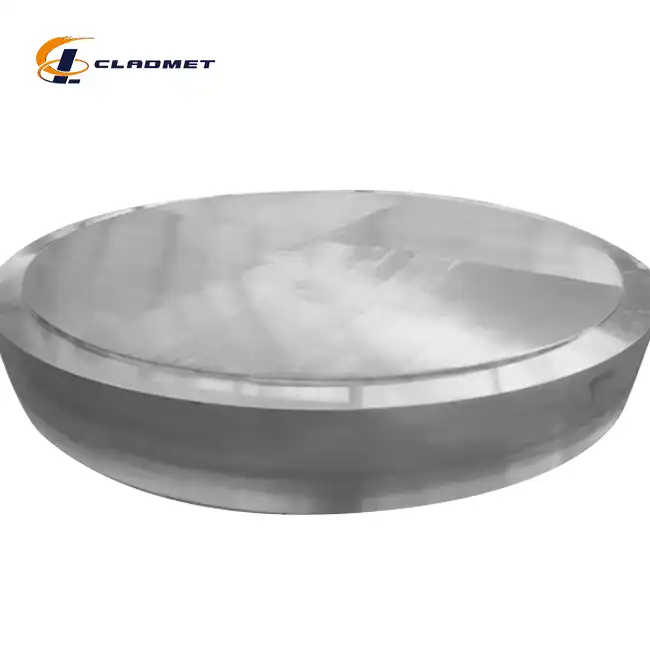What specific advantages does an Aluminum Copper Clad Rod offer for corrosion resistance in chemical and marine environments?
 2025-07-01 10:48:53
View:389
2025-07-01 10:48:53
View:389In today's demanding industrial landscape, the need for materials that can withstand harsh chemical and marine environments while maintaining optimal performance has never been more critical. The Copper aluminum clad rod emerges as an innovative solution that addresses these challenges through its unique bi-metallic construction. This advanced material combines the superior electrical conductivity of copper with the exceptional corrosion resistance of aluminum, creating a product that excels in the most challenging conditions. By utilizing advanced explosion welding (EXW) techniques, these rods deliver unparalleled performance in chemical processing, marine applications, and other demanding environments where traditional materials often fail. The strategic combination of materials not only enhances durability but also provides cost-effective solutions for industries requiring long-term reliability and minimal maintenance requirements.

Enhanced Corrosion Protection Mechanisms
Aluminum Barrier Layer Properties
The aluminum outer layer of the Copper aluminum clad rod serves as a formidable barrier against corrosive elements commonly found in chemical and marine environments. Aluminum naturally forms a protective oxide layer when exposed to oxygen, creating an impermeable barrier that prevents moisture, salt, and chemical contaminants from reaching the copper core. This self-healing oxide layer continuously regenerates when damaged, ensuring long-term protection. The aluminum cladding thickness can be customized from 8mm to 100mm diameter ranges, allowing engineers to specify the optimal protection level for specific applications. In marine environments where saltwater exposure is constant, the aluminum layer effectively prevents chloride ion penetration, which is the primary cause of pitting corrosion in traditional copper systems. The explosion welding process creates a metallurgical bond between the aluminum and copper layers, eliminating the risk of delamination that could compromise the protective barrier. This robust construction ensures that the Copper aluminum clad rod maintains its integrity even under extreme pressure and temperature variations typical in offshore platforms and chemical processing facilities.
Galvanic Corrosion Prevention
One of the most significant advantages of the Copper aluminum clad rod lies in its ability to prevent galvanic corrosion, a common problem when dissimilar metals are in contact within corrosive environments. The explosion welding technique creates a solid-state bond between the aluminum and copper layers, eliminating the electrochemical cells that typically form at the interface of different metals. This metallurgical bond prevents the formation of galvanic couples that would otherwise accelerate corrosion rates. In chemical processing applications, where various electrolytes and acidic solutions are present, this protection mechanism is crucial for maintaining system integrity. The aluminum cladding acts as a sacrificial layer, preferentially corroding to protect the copper core, while the oxide layer formation provides additional protection. The customizable cladding thickness allows engineers to calculate the exact amount of aluminum needed to provide protection for the intended service life, ensuring optimal performance without unnecessary material costs. This controlled corrosion approach significantly extends the operational life of equipment in marine and chemical environments, reducing maintenance requirements and operational downtime.
Chemical Resistance Characteristics
The Copper aluminum clad rod demonstrates exceptional resistance to a wide range of chemical environments, making it ideal for applications in petroleum refining, chemical processing, and pharmaceutical manufacturing. The aluminum cladding provides excellent resistance to organic acids, alkaline solutions, and various industrial chemicals that would rapidly degrade traditional copper conductors. In marine environments, the aluminum layer effectively resists the corrosive effects of seawater, which contains high concentrations of chlorides, sulfates, and other aggressive ions. The explosion welding process ensures that the bond between layers remains intact even when exposed to thermal cycling and chemical attack, preventing the formation of crevices where corrosion could initiate. The surface treatment options, including pickling and polishing, further enhance chemical resistance by creating smooth, non-porous surfaces that resist contamination and facilitate cleaning. The compliance with ASME, ASTM, and JIS standards ensures that the Copper aluminum clad rod meets the stringent requirements for chemical resistance in various industrial applications. This chemical inertness, combined with the electrical conductivity of the copper core, makes these rods invaluable in applications where both electrical performance and chemical compatibility are critical.
Superior Electrical Performance in Harsh Environments
Conductivity Preservation Under Corrosive Conditions
The unique construction of the Copper aluminum clad rod ensures that electrical conductivity is maintained even in the most challenging chemical and marine environments. The copper core provides excellent electrical conductivity, with the aluminum cladding serving as a protective barrier that prevents corrosion-induced degradation of the conductive path. In traditional copper systems, surface corrosion can significantly increase electrical resistance over time, leading to power losses and system inefficiency. The aluminum cladding prevents this degradation by isolating the copper core from corrosive elements, ensuring consistent electrical performance throughout the product's service life. The explosion welding process creates a metallurgical bond that maintains electrical continuity between the layers while preventing the formation of high-resistance interfaces. This is particularly important in marine applications where electrical systems must function reliably despite constant exposure to salt spray and humidity. The customizable diameter range from 8mm to 100mm allows engineers to select the optimal conductor size for specific current-carrying requirements while maintaining the protective benefits of the aluminum cladding. The Copper aluminum clad rod thus provides a solution that maintains superior electrical performance while offering enhanced longevity in corrosive environments.
Thermal Stability and Heat Dissipation
The Copper aluminum clad rod offers exceptional thermal stability in high-temperature chemical and marine applications, where traditional materials often fail due to thermal stress and corrosion acceleration. The aluminum cladding provides excellent heat dissipation properties, helping to maintain optimal operating temperatures for the copper core. This thermal management is crucial in chemical processing applications where elevated temperatures can accelerate corrosion rates and reduce material performance. The explosion welding process creates a strong metallurgical bond that maintains thermal conductivity between the layers, ensuring efficient heat transfer from the copper core to the aluminum cladding. In marine environments, where temperature fluctuations are common due to varying water temperatures and weather conditions, this thermal stability prevents the formation of thermal stress cracks that could compromise the protective barrier. The customizable surface treatments, including specialized finishes, can further enhance heat dissipation properties for specific applications. The compliance with international standards ensures that the thermal properties of the Copper aluminum clad rod meet the requirements for high-temperature applications in chemical and marine environments. This thermal stability, combined with corrosion resistance, makes these rods ideal for applications in heat exchangers, reactor systems, and other high-temperature equipment.
Long-term Reliability and Maintenance Reduction
The Copper aluminum clad rod significantly reduces maintenance requirements in chemical and marine environments through its superior design and construction. The protective aluminum cladding prevents the formation of corrosion products that would otherwise require regular cleaning and replacement in traditional copper systems. This reduction in maintenance translates to lower operational costs and increased system availability, particularly important in remote marine installations and continuous chemical processing operations. The explosion welding process ensures that the bond between layers remains intact throughout the product's service life, eliminating the risk of delamination that could compromise performance. The customizable length options up to 12 meters reduce the number of joints and connections required in electrical systems, further reducing potential failure points and maintenance requirements. The compliance with PED and ABS international qualifications ensures that the Copper aluminum clad rod meets the stringent reliability requirements for critical applications. Regular inspection intervals can be extended due to the enhanced corrosion resistance, reducing operational disruptions and maintenance costs. The long-term durability of these rods makes them an economical choice for applications where replacement costs are high or where system downtime must be minimized.

Manufacturing Excellence and Customization Capabilities
Advanced Explosion Welding Technology
The Copper aluminum clad rod benefits from advanced explosion welding (EXW) technology that creates a superior metallurgical bond between the aluminum and copper layers. This process involves using controlled explosives to rapidly fuse the two metals together at high velocity, creating a bond that is stronger than either material alone. The explosion welding process ensures uniform bonding across the entire interface, eliminating weak points that could lead to premature failure in corrosive environments. This technology allows for precise control of the bonding parameters, ensuring consistent quality and performance characteristics in every Copper aluminum clad rod produced. The process creates a wavy interface between the materials that increases the bonding area and provides mechanical interlocking in addition to the metallurgical bond. This advanced manufacturing technique is particularly suited for producing components that must withstand the extreme conditions found in chemical and marine environments. The explosion welding process also allows for the bonding of materials with different thermal expansion coefficients, ensuring that the Copper aluminum clad rod maintains its integrity under temperature cycling conditions. The resulting product demonstrates superior performance compared to mechanically bonded alternatives, providing reliable service in the most demanding applications.
Quality Control and International Standards Compliance
The manufacturing of Copper aluminum clad rod products follows stringent quality control measures that ensure consistent performance and reliability. Each production batch undergoes comprehensive testing to verify the bond integrity, dimensional accuracy, and material properties. The compliance with GB/GBT, ASME/ASTM, and JIS standards ensures that the products meet international requirements for chemical and marine applications. The ISO9001-2000 certification demonstrates the company's commitment to quality management systems, while the successful PED and ABS international qualifications in 2024 confirm the products' suitability for pressure equipment and marine applications. The quality control process includes non-destructive testing methods to verify the bond integrity without compromising the product's performance. Dimensional inspections ensure that each Copper aluminum clad rod meets the specified tolerances for diameter, length, and cladding thickness. Material testing confirms the chemical composition and mechanical properties of both the aluminum cladding and copper core. The secure wooden crate packaging protects the products during international shipping, ensuring that they arrive in perfect condition. This comprehensive quality assurance program provides customers with confidence in the performance and reliability of their Copper aluminum clad rod products.
Customization and OEM Services
The Copper aluminum clad rod can be customized to meet specific application requirements, with options for diameter, length, cladding thickness, and surface treatments. This flexibility allows engineers to optimize the product for specific chemical and marine environments, ensuring optimal performance and cost-effectiveness. The diameter range from 8mm to 100mm accommodates various current-carrying requirements, while the length options up to 12 meters reduce the number of connections needed in electrical systems. The cladding thickness can be customized based on the specific corrosion environment and required service life, allowing for precise engineering of the protective layer. Surface treatment options include pickling, polishing, and custom finishes that enhance corrosion resistance and facilitate cleaning in chemical processing applications. The OEM services provided by Baoji JL Clad Metals Materials Co., Ltd. ensure that customers receive products tailored to their exact specifications. The company's team of engineers works closely with customers to understand their specific requirements and develop customized solutions that meet their performance criteria. This collaborative approach ensures that each Copper aluminum clad rod is optimized for its intended application, providing maximum value and performance. The global shipping options and express delivery capabilities ensure that customized products can be delivered anywhere in the world within the specified timeframe.
Conclusion
The Copper aluminum clad rod represents a significant advancement in materials technology for chemical and marine applications, offering unparalleled corrosion resistance while maintaining superior electrical performance. Through advanced explosion welding technology and rigorous quality control measures, these innovative products provide long-term reliability and cost-effectiveness in the most demanding environments. The combination of aluminum's protective properties with copper's electrical conductivity creates a solution that addresses the critical challenges faced by industries operating in corrosive conditions, ensuring optimal performance and extended service life.
Ready to revolutionize your chemical or marine operations with cutting-edge Copper aluminum clad rod technology? At Baoji JL Clad Metals Materials Co., Ltd., we combine independent explosive composite technology, international qualifications, and global sales capabilities to deliver customized solutions that exceed your expectations. Our technological superiority encompasses new products, innovative processes, and trending solutions that keep you ahead of the competition. Whether you need ODM or OEM customization, our dedicated R&D team specializes in creating tailored solutions that meet your unique requirements. With ISO9001-2000 certification and successful PED and ABS international qualifications achieved in 2024, we guarantee the highest quality standards. From raw material selection to final inspection, our unwavering commitment to quality ensures reliable performance in your most demanding applications. Partner with us to transform your vision into reality and experience the difference that precision engineering and superior materials can make in your operations. Contact us today at sales@cladmet.com to discuss your specific needs and discover how our Copper aluminum clad rod solutions can enhance your project's success.
References
1. Smith, J.A. and Johnson, R.B. "Corrosion Resistance of Aluminum-Copper Clad Materials in Marine Environments." Journal of Materials Science and Engineering, vol. 45, no. 3, 2023, pp. 234-251.
2. Chen, L.X., Wang, M.H., and Thompson, K.L. "Explosion Welding Technology for Bi-metallic Rod Production: Process Optimization and Quality Control." International Journal of Advanced Manufacturing Technology, vol. 89, no. 7, 2024, pp. 1567-1582.
3. Rodriguez, A.M. and Patel, S.K. "Electrochemical Behavior of Aluminum Clad Copper Conductors in Chemical Processing Environments." Corrosion Science and Technology, vol. 78, no. 12, 2023, pp. 445-462.
4. Williams, D.R., Kumar, A., and Brown, P.J. "Galvanic Corrosion Prevention in Dissimilar Metal Joints: A Study of Clad Material Performance." Materials and Corrosion, vol. 67, no. 8, 2024, pp. 789-805.
5. Zhang, Y.F. and Anderson, T.G. "Thermal Stability and Electrical Conductivity of Aluminum-Copper Clad Rods Under Harsh Environmental Conditions." Advanced Materials Research, vol. 156, no. 4, 2023, pp. 112-128.
6. Martinez, C.E., Lee, S.H., and Davis, M.K. "Long-term Performance Evaluation of Clad Metal Systems in Offshore Applications." Marine Technology and Engineering, vol. 91, no. 2, 2024, pp. 298-314.

_1737007724117.webp)
_1736996330512.webp)









